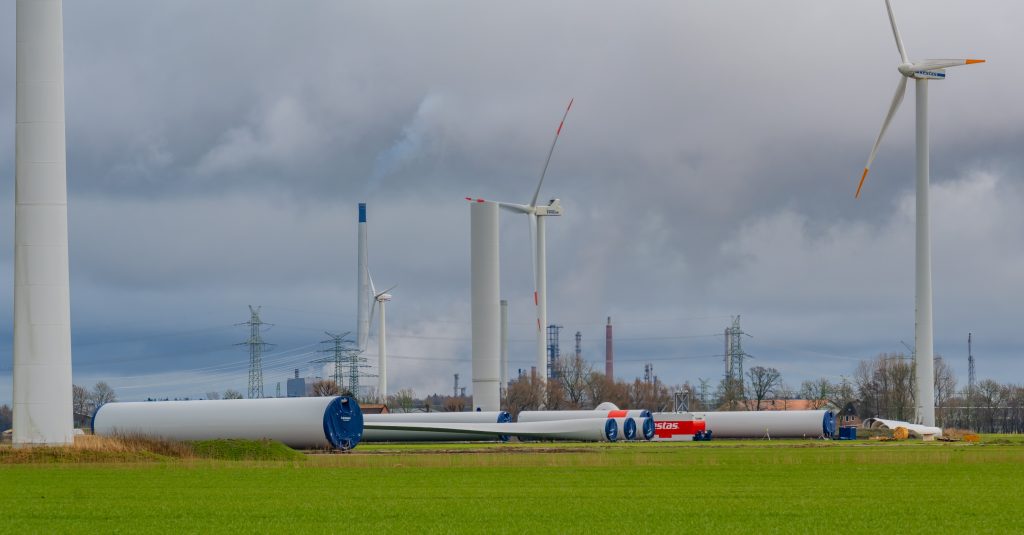Wind power construction site near Hamburg in 2023. Germany needs a lot of new environmentally friendly energy – and ways to store it. (Image: Shutterstock)
Germany has unveiled a new ambitious national hydrogen strategy that will guide the country towards greenhouse gas neutrality by 2045. The goal is to improve Germany’s energy efficiency, eliminate the carbon-based raw materials in its energy production that still largely relies on fossil fuels, and secure future hydrogen supply through international partnerships. This opens up opportunities for Nordic players.
The newly updated National Hydrogen Strategy is a cornerstone of Germany’s roadmap to greenhouse gas neutrality. With a focus on renewable energy sources like hydrogen, the strategy outlines goals, implementation methods, and available funding to foster a sustainable energy future.
Goals of the National Hydrogen Strategy
Hydrogen is a multifaceted chemical feedstock and energy carrier, pivotal for securing energy supplies across numerous sectors. If produced sustainably, hydrogen can drastically reduce carbon emissions. However, its production is energy-intensive and costly, necessitating substantial investments and a robust infrastructure. The Federal Government of Germany supports these efforts with several billion euros in federal and state funds.
Key Objectives:
- Establishing renewable hydrogen as a critical element of the energy transition.
- Creating a domestic hydrogen market and building production capacity.
- Developing a regulatory framework for hydrogen transport and distribution.
- Enhancing the competitiveness of German companies in hydrogen technologies.
- Securing future hydrogen supply through international partnerships.
Hydrogen Strategy Action Plan
The strategy includes an action plan with specific measures divided into eight key areas:
- Hydrogen Production
- Industrial-scale generation plants for green hydrogen.
- Expansion of renewable energy to supply green electricity.
- Investment in hydrogen applications in viable sectors like steel and chemical industries.
- Transport
- Promoting hydrogen for sustainable mobility in large and heavy vehicles.
- Funding for research, development, and hydrogen vehicles in road, air, and maritime transport.
- Industrial Sector
- Transitioning from fossil technologies to low-GHG or GHG-neutral processes.
- Projects like Carbon2Chem to convert blast-furnace gases into input products for various uses.
- Heat
- Promoting fuel cell heating appliances in buildings.
- Evaluating and potentially continuing grant schemes for fuel cell technology.
- Infrastructure/Supply
- Ensuring efficient hydrogen supply and exploring repurposing existing infrastructure.
- Expanding hydrogen refuelling stations for transport networks.
- Research, Education, and Innovation
- Funding initiatives to drive technological innovation in hydrogen.
- Projects like H2Giga, H2Mare, and TransHyDE, and the Hydrogen Research Network.
- European Level Action
- Driving hydrogen technologies at the EU level.
- Developing sustainability and certification standards for hydrogen.
- International Hydrogen Market and Partnerships
- Building global partnerships to meet hydrogen demand through imports.
- Securing Germany’s hydrogen import requirements and export opportunities.
Governance of the Hydrogen Strategy
Effective governance ensures continuous progress monitoring and stakeholder involvement. The governance structure includes:
- State Secretaries’ Committee on Hydrogen: Decision-making body for the strategy, taking corrective actions as needed.
- National Hydrogen Council: An advisory body with 25 experts from various sectors.
- Hydrogen Coordination Office: Supports the implementation and monitoring of the strategy.
- Federal-State Cooperation: Coordination between federal and state levels through a working group.
Implementation Status
Since its adoption in June 2020, the strategy has seen significant progress, including:
- Launch of the IPCEI with 62 projects funded.
- Introduction of funding programmes for hydrogen technologies in industries.
- Establishment of national and international partnerships for hydrogen production and supply.
Germany to be the leader in hydrogen technologies
The National Hydrogen Strategy represents a bold step towards a sustainable and climate-neutral future for Germany. With ongoing revisions and continuous support from the Federal Government, the strategy aims to foster private-sector investment, drive technological innovation, and secure Germany’s position as a leader in hydrogen technologies on the global stage. This also opens up opportunities and export markets for Nordic hydrogen players.
Read More:
The Federal Government of Germany: The National Hydrogen Strategy
https://www.bmwk.de/Redaktion/EN/Hydrogen/Dossiers/national-hydrogen-strategy.html

